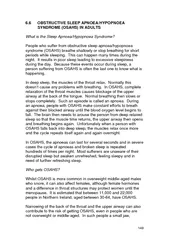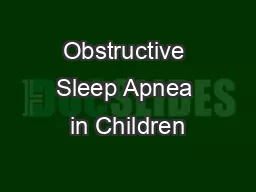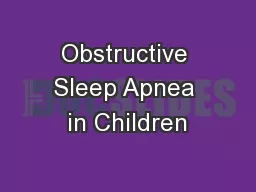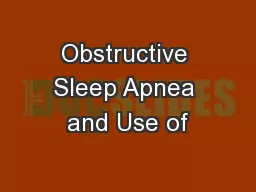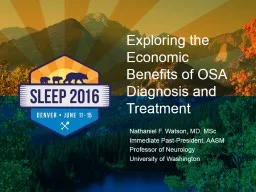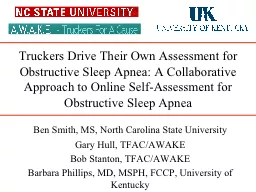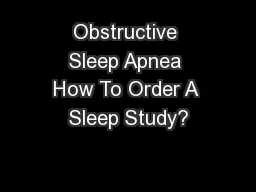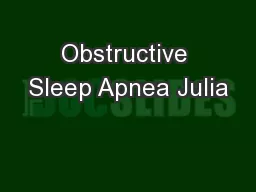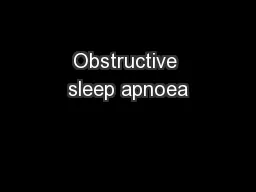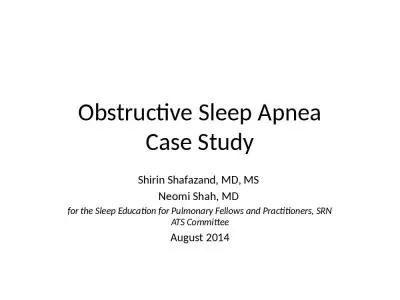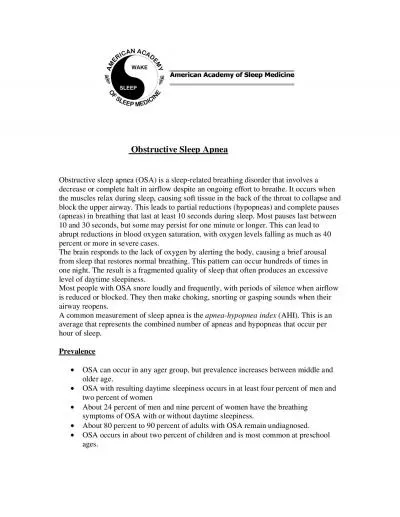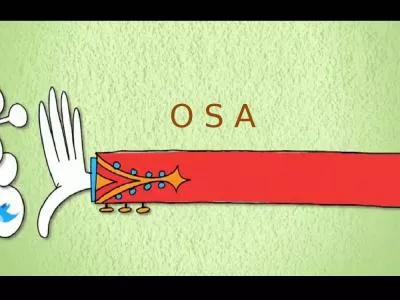PPT-OBSTRUCTIVE SLEEP APNOEA [OSA]
Author : natalia-silvester | Published Date : 2018-03-06
OSA a common problem Two types of breathing interruption characteristic of OSA APNOEA where the muscles and soft tissues in the throat relax and collapse sufficiently
Presentation Embed Code
Download Presentation
Download Presentation The PPT/PDF document "OBSTRUCTIVE SLEEP APNOEA [OSA]" is the property of its rightful owner. Permission is granted to download and print the materials on this website for personal, non-commercial use only, and to display it on your personal computer provided you do not modify the materials and that you retain all copyright notices contained in the materials. By downloading content from our website, you accept the terms of this agreement.
OBSTRUCTIVE SLEEP APNOEA [OSA]: Transcript
OSA a common problem Two types of breathing interruption characteristic of OSA APNOEA where the muscles and soft tissues in the throat relax and collapse sufficiently to cause a total blockage of the airway. It occurs when the muscles relax during sleep causing soft tissue in the back of the throat to collapse and block the upper airway This l eads to partial redu ctions hypopneas and complete pauses apneas in breathing that last at least 10 s econds du 6 OBSTRUCTIVE SLEEP APNOEA HYPOPNOEA SYNDROME OSAHS IN ADULTS What is the Sleep ApnoeaHypopnoea Syndrome People who suffer from obstructive sleep apnoeahyp opnoea syndrome OSAHS breathe shallowly or stop breathin g Alyssa Brzenski. Case . A 31 month old term 17kg girl presents for Tonsillectomy and Adenoidectomy as an outpatient. She has a history of frequent ear infections, which have resolved since ear tubes were placed. According to her mom she snores loudly and is much more active than the other children her age. Mom doesn’t think that she stops breathing at night but notices that she always breathes through her mouth and always seems to have bad breath. She has no other past medical history. On exam you observe an overweight female with grade III tonsils but an otherwise unremarkable airway, heart and lung exam.. Morton Plant . Mease. Healthcare. Clearwater, FL. The Need for . Perioperative. Screening in Sleep Apnea Patients. Discuss the importance of recognizing undiagnosed obstructive sleep apnea (OSA). Review the patients at risk for OSA. Alyssa Brzenski. Case . A 31 month old term 17kg girl presents for Tonsillectomy and Adenoidectomy as an outpatient. She has a history of frequent ear infections, which have resolved since ear tubes were placed. According to her mom she snores loudly and is much more active than the other children her age. Mom doesn’t think that she stops breathing at night but notices that she always breathes through her mouth and always seems to have bad breath. She has no other past medical history. On exam you observe an overweight female with grade III tonsils but an otherwise unremarkable airway, heart and lung exam.. Capnography. 0930-1045. . 1. Objectives. Describe . obstructive Sleep apnea (OSA). Identify risk factors with obstructive sleep apnea and other sleep disorders. Describe medical conditions that are impacted with OSA. Commissioned by the American Academy of Sleep Medicine . Published August . 2016. Epidemiology. Source: Primary research with experts, U.S. Census (2014), Peppard . "Increased Prevalence of Sleep-disordered Breathing in Adults." . Approach to Online Self-Assessment for Obstructive Sleep Apnea. Ben Smith, MS, North Carolina State University. Gary Hull, TFAC/AWAKE. Bob Stanton, TFAC/AWAKE. Barbara Phillips, MD, MSPH, FCCP, University of Kentucky. Herbert M. . Schub,MD. Chief, Pulmonary Diseases. Highland Alameda County Hospital. Clinical Professor of Medicine, UCSF. Obstructive Sleep Apnea. Obstructive Apneas,. . Hypopneas,or. . Respira. -. Buchfuhrer. , PGY-II. Updated March 2018. Objectives. Define OSA. Recognize Risk Factors for OSA. Know when to refer for PSG. Know the available treatments for OSA. Case. 52y/o obese gentleman comes into clinic complaining of being tired everyday. He often falls asleep at work or while driving home. He gets about 8 hours of sleep most nights and falls asleep right away.. Alister Neill. TE HA ORA . MOE. THE BREATH OF LIFE (SLEEPING). Sleep health. Sleep that is fully restorative, enabling full potential. Achieving optimum total sleep time. Major health issues. Sleep deprivation (TST < 5 hours/ night). Shirin. Shafazand, MD, MS . Neomi. Shah, MD . for the Sleep Education for Pulmonary Fellows and Practitioners, SRN ATS Committee. August 2014. Part 1: Case Presentation. Mr. Simon Applegate (SA) is a 55 year old male who comes to your office with complaints of shortness of breath. He has gained 10 . decrease or complete halt in the muscles relax during sleep, causing soft tissue ctions (hypopneas) and complete pauses 10 and 30 seconds, but some may persist for one minute or longer. This can lead ABDULLAH AHMAD BADAWI. (2003 – 2009). Underwent surgery 4 years ago, shared his experience to . Utusan. Malaysia just recently to raise awareness among . M’sians. about OSA. Early detection of OSA has prevented him from being diagnosed with a serious heart disease.
Download Document
Here is the link to download the presentation.
"OBSTRUCTIVE SLEEP APNOEA [OSA]"The content belongs to its owner. You may download and print it for personal use, without modification, and keep all copyright notices. By downloading, you agree to these terms.
Related Documents

![PPT-OBSTRUCTIVE SLEEP APNOEA [OSA]](https://thumbs.docslides.com/641111/obstructive-sleep-apnoea-osa.jpg)
